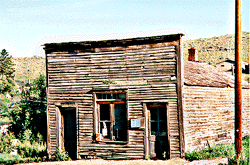Hangman's Building
Updated: August 21, 2020

In late 1863, Griffith & Thompson, builders of many of the early structures in the City, began construction of a log store on the corner of Wallace and Van Buren.
On January 14, 1864, the building was only partly finished. The log walls were up and a heavy, main beam to support the roof had been erected, but there was no roof. On that morning, the Vigilantes captured five criminals and were determined to see them punished. A short trial was held in front of the Virginia Hotel, diagonally across the street (later called the O.K. Livery Stable). The men's guilt was without question and their crimes judged to be of devastating nature.
The five murderers were marched to the unfinished building. After a period of last requests, the death sentence was given. Their lives were not spared, and Clubfoot George Lane died first. The road agents were placed on the sidewalk in front of the building after the hanging and were buried on Boot Hill by their friends.
The building in which the hangings took place was completed and purchased by S. R. Hale, a druggist, soon after he arrived in Virginia City on July 10, 1864. Hale went to Helena in 1865, but his partner, Clayton, continued in Virginia City.
In 1868 the firm was known as Clayton and Morris and, by 1873, W. W. Morris ran it independently. Morris later merged with J. V. Hinckman and S. H. Crockett, the firm from which was later to come Rank's Drug. The drug store evidently moved from the Hangman's Building to Rank's about 1877.
There is some relationship between O. B. Barber, partner of D. W. Tilton and the W. W. Morris Drug Store. In 1875 O. B. Barber listed his address as "No.13, Wallace Street," which is possibly the Hangman's Building. It stands on Lot 13, Block 156, and has the obvious connotation of "13" due to its one-time use.
In 1880 Mrs. Mary Deimling succeeded her husband as Postmistress of Virginia City and moved the post office from the Olinghouse Block to the Hangman's Building, where it is shown on the 1884 fire-insurance map. It remained here until 1887, when O. D. French became Postmaster and moved it across the street to Creighton's Stone Block. About 1892 C. W. Mead, U.S. Deputy Mineral Surveyor, occupied the building.
In 1903 the Virginia City Water Company purchased the building from W. W. Morris, who had become a successful banker in Pony but retained the historic structure in Virginia City. The Water Company founded January 27, 1865, by A. M. Holter and others, originally used hollowed-out logs for pipes. Stephen Bickford, who arrived in Virginia City in 1863 and engaged in mining and ranching, bought two-thirds of the Water Company in 1888. He devoted all of his time to the water works, developing a large spring northeast of town. Before he died of pneumonia in 1900, he had succeeded in placing running water at the doorstep of almost every resident in town and some of the original wooden pipes were still in operation in 1971, when the present plastic pipe system was installed.
After Bickford's death his widow, Sarah Gammon Bickford, carried on the Water Company. She was one of the blacks in Montana in the early days, and the Bickford family was probably one of the only black families in the United States to own a public utility. It was a remarkable feat in a time when there were almost no women and few blacks, of either sex, in business.
While the Hangman's Building was owned by Mrs. Bickford, the center doors were partly covered and two new doors placed where windows had been previously — resulting in its present appearance. After Mrs. Bickford's death in 1939, her son Elmer ran the water works for a while, and it was eventually sold to the city. Charles A. Bovey purchased the Hangman's Building from the Bickfords in 1947.
Special acknowledgements to: John D. Ellingsen, John N. DeHass, Tony Dalich, and Ken Sievert, Tom Cook and Ellen Baumler of the Montana Historical Society.
Updated: August 21, 2020

